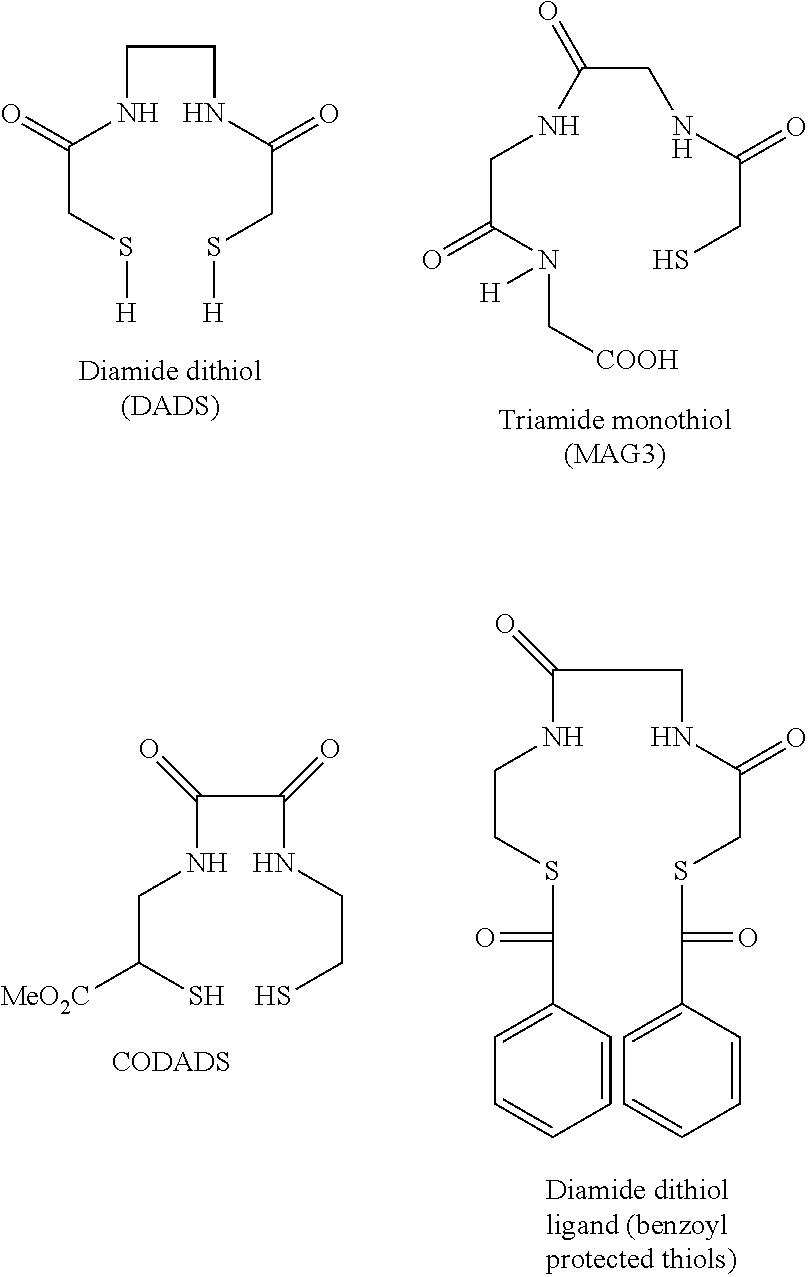Chelation of metals to thiol groups using in situ reduction of disulfide-containing compounds by phosphines
a technology of metals and thiol groups, which is applied in the field of radiopharmaceutical forms comprising radionuclide chelators, can solve the problems of limited in vivo stability, difficult manufacture and formulation of products based on thiol-containing ligands, and reduce the purity of ligands
- Summary
- Abstract
- Description
- Claims
- Application Information
AI Technical Summary
Benefits of technology
Problems solved by technology
Method used
Image
Examples
example 1
Synthesis and Characterization of Compound 1 TFA Salt
[0126]Synthesis of compound 1 was carried out in dimethyl formamide (DMF) using HOBt / DIC activation on rink-amide Novagel resin. Fmoc deprotection was carried out with 20% piperidine DMF. The resin was swelled in DMF for 1 h before use. All couplings were of 2 hours duration except for the last N,N-dimethylglycine coupling (see below). The following scheme was used.
[0127]A typical coupling cycle is as follows: To a 50-mL SPPS reaction vessel containing 1.13 mmol of the swelled resin (0.6 mmol / g, Novabiochem) was added a solution of 4.52 mmol of an Fmoc-amino acid in DMF (EM Science), 4.52 mmol of HOBT (Novabiochem) in DMF, and 4.52 mmol of DIC. The total volume of DMF was 20 mL. The reaction mixture was shaken for 2 h. The resin was then filtered and washed with DMF (3×30 mL). A ninhydrin test was carried out to confirm the completion of the coupling. A solution of 20% piperidine in DMF (20 mL) was added to the resin and it was sh...
example 2
Preparation of Compound 2 from Compound 1
[0135]Compound 2, a disulfide dimer was prepared by aerial oxidation of Compound 1 following the procedure outlined below:
[0136]To a solution of 150 mg of Compound 1 in 2 mL of DMSO was added 40 mL, of H2O (0.1% TFA). The pH of the clear solution was adjusted to 7 by adding saturated aqueous (NH4)2CO3. It was stirred at RT in the open air for 2 days. The reaction was monitored by MS and HPLC to follow the progress of the oxidation. At completion, 30 mL of H2O (0.1% TFA) was added to the cloudy mixture and it turned clear. It was loaded onto a YMC C-18 preparative HPLC column. The gradient was started at 5% CH3CN / H2O (0.1% TFA), increased to 14% organic in 9 min., then ramped from 14 to 34% organic in 80 min. The fractions containing desired product were lyophilized and a total of 93 mg of pure material was obtained. The analytical results for this compound are given below.
[0137]Mass Spec: a doubly charged ion at 1371.0; a triple charged ion a...
example 3
Synthesis of Compound 9
[0139]The following scheme was used to prepare Compound 9.
[0140]Peptide (4): Compound 3 was obtained from Bachem. Synthesis of peptide 4 was carried out on a 0.25 mmol scale using an ABI 433 A synthesizer with the FastMoc protocol (Applied Biosystems Inc.). The peptide was made using 0.4 g of Rink amide Nova Gel HL resin, (resin substitution 0.6 mmol / g).
[0141]In each cycle of this protocol, 1.0 mmol of a dry protected amino acid in a cartridge was dissolved in a solution of 0.9 mmol of HBTU, 2 mmol of DIEA, and 0.9 mmol of HOBt in DMF with additional NMP added. The coupling time in this protocol was 21 min. Peptide loaded resin 4 (0.7 g) was obtained from ABI synthesizer. Fmoc deprotection was carried out with 20% piperidine in DMF (2×10 mL) for 10 min. The peptide bound resin 4 was washed with DMF (3×10 mL) and CH2Cl2 (3×10 mL) and dried.
[0142]Compound (7) (Luyt et al. Bioconjugate Chem., 1999, Vol 10, 470-479): Concentrated sulfuric acid (5 g) was added to a...
PUM
| Property | Measurement | Unit |
|---|---|---|
| temperature | aaaaa | aaaaa |
| temperature | aaaaa | aaaaa |
| single photon energy | aaaaa | aaaaa |
Abstract
Description
Claims
Application Information
 Login to View More
Login to View More - R&D
- Intellectual Property
- Life Sciences
- Materials
- Tech Scout
- Unparalleled Data Quality
- Higher Quality Content
- 60% Fewer Hallucinations
Browse by: Latest US Patents, China's latest patents, Technical Efficacy Thesaurus, Application Domain, Technology Topic, Popular Technical Reports.
© 2025 PatSnap. All rights reserved.Legal|Privacy policy|Modern Slavery Act Transparency Statement|Sitemap|About US| Contact US: help@patsnap.com



